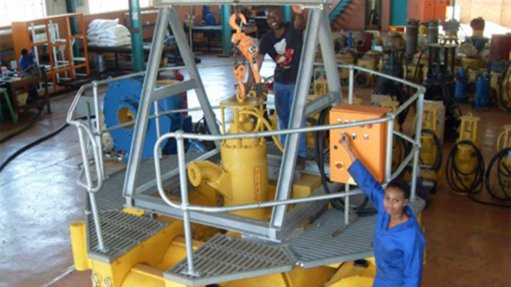
HIPPO Submersible Slurry Pump® mounted on pontoon complete with electrical switchgear and lifting equipment
Hazleton Pumps has been actively involved with the de-silting of tailings dams – specifically in Canada. The HIPPO Flameproof Medium-High Voltage; High Volume; Submersible Slurry Pump® has successfully been used to de-silt the
tailings dam at the Oil Sands mines in Fort McMurray, Alberta since 2005.
The HIPPO Model 250-300M HIPPO Submersible Slurry Pumps are used to successfully combat the threat of pollution by de-silting the tailings dams. The pumps operate at a power supply of 4160 Volts; absorbing 350 kW while pumping slurry at a rate of 1 000 m3/h and at a head of 78 m, under temperature conditions varying from -40 oC in the winter to +30oC in the summer.
The HIPPO Submersible Slurry Pump Range® is manufactured locally with a 98% local content – with only the bearings and the mechanical seals being importedand due to success of the HIPPO Solid Separation System Hazleton Pumps® has expanded the HIPPO Submersible pump “Solid Separation System” to de-silt dams.
All major dams are silted up to such an extent that the storage capacity has been compromised and the action plan that needs to be put in place is to restore the dams to their original capacity. The silt settled at the bottom of the dam could
contain as much as 40% water by volume and by de-silting the dam not only is the capacity of the dam increased but also the water recovered will add additional water to the dam’s capacity.
Using the HIPPO Submersible Slurry Pump®, mounted on a pontoon equipped with a lifting and lowering device, the pump is lowered into the sediment or liquid with a high percentage of solids (up to 65% on average) to pump the silt
from the dam to the surface.
HIPPO Submersible Slurry Pump® mounted on pontoon complete with electrical switchgear and lifting equipment.
The HIPPO Solid Separation System® is installed next to the dam in a specific position above the surface level of the dam and the silt is recovered to be processed or re-used while the water is returned to the dam. In most dams the silt has a high concentration of minerals and phosphates which can be used in the agricultural and industries at a viable cost. Often the silt can be use as potting soil and should the phosphate contents be high enough it could
be used as fertilizer.
The main requirements to set up dam de-silting recovery system are as follows:
- Establish the chemical composition of the silt so as to find a market for the silt to be sold either as potting soil or fertilizer.
- Ensure sufficient electrical power available as the rate with which a desilting project can be achieved is directly proportional to the power available.
- Establish that an area of sufficient size is available to install the solid separation system as well as loading/storage area for the silt. If possible, the silt could be bagged directly from the solid separation system before transportation.
- Establish a distribution network to supply end users such as nurseries and other or establish a storage area until such a network is in place.
Throughout South Africa, especially in the Western and Eastern Cape provinces the serious water shortages currently experienced could possibly have been averted if the storage capacity of the dams enjoyed the attention it deserved in
the past.The various alternative methods to produce water in these arid regions are allshort-term solutions, as the storage capacity of existing dams is of far greater importance.
It is recommended that all involved in the Western Cape with finding long-term solutions to the storage of water and the capacity of the dams get onboard to find an economical solution which would include the immediate
implementation of an efficient de-silting program.